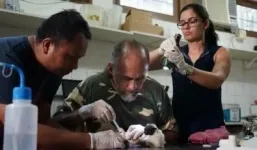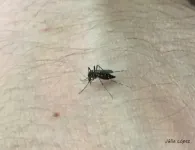(Press-News.org) By Maria Fernanda Ziegler | Agência FAPESP – Yellow fever was the first human disease to have a licensed vaccine and has long been considered important to an understanding of how epidemics happen and should be combated. It was introduced to the Americas in the seventeenth century, and high death rates have resulted from successive outbreaks since then. Epidemics of yellow fever were associated with the slave trade, the US gold rush and settlement of the Old West, the Haitian Revolution, and construction of the Panama Canal, to cite only a few examples.
Centuries after the disease was first reported in the Americas, an international team of researchers will embark on a groundbreaking study to develop models that predict epidemics of yellow fever and other diseases caused by mosquito-borne arboviruses such as dengue, zika, and chikungunya.
“Knowledge of these diseases, their cycles ,and the possibilities of new outbreaks is very well-established, but we still lack a systematic understanding of how to predict when outbreaks will occur. Our goal is to create predictive models to help monitor and combat outbreaks, protect the public, and develop a deeper understanding of the combination of factors that leads to epidemics,” said Maurício Lacerda Nogueira, a professor at the São José do Rio Preto Medical School (FAMERP) in the state of São Paulo, Brazil, and a member of the CREATE-NEO project funded by the US National Institutes of Health (NIH).
The new study is part of a Thematic Project supported by FAPESP to monitor the mosquito population in the urban area of São José do Rio Preto and the monkey and mosquito populations in the transition zone between rural and urban Manaus, the Amazonas state capital.
In addition to FAMERP, the Brazilian research centers that are participating in the initiative include the National Institute for Research on the Amazon (INPA), the Federal University of Mato Grosso (UFMT), the Federal University of Amazonas (UF AM), and the Heitor Vieira Dourado Foundation for Tropical Medicine (FMT-HVD). Participants located elsewhere include the University of Texas Medical Branch (UTMB), New Mexico State University (NMSU), the Massachusetts Institute of Technology (MIT), and Cary Institute of Ecosystem Studies in the US, and the Gorgas Memorial Institute for Health Studies (ICGES) in Panama, among others.
An article written by the researchers to mark the project’s inception is published in Emerging Topics in Life Science, reviewing the factors that influence the potential re-emergence of yellow fever in the Neotropics.
“Deforestation, seasonal variations in rainfall and non-human primate populations are all factors that influence outbreaks, but we need to know the tipping-point for each one, and to find that out we’ll develop predictive models based on research and monitoring conducted in arbovirus hotspots in São Paulo, Amazonas and the Pantanal in Brazil, and in Panama,” Nogueira said.
The history of yellow fever shows that outbreaks occur at intervals of between seven and ten years. “Brazil has many arboviruses, with outbreaks and even epidemics in progress all the time,” said Livia Sacchetto, also a researcher at FAMERP and a member of CREATE-NEO.
From forest to city and vice-versa
According to Sacchetto, the project also aims to find out more about spillovers and, if possible, anticipate these outbreaks in which arboviruses jump from humans to animals or vice-versa. Dengue, zika, and chikungunya are transmitted to humans and non-human primates by infected Aedes aegypti mosquitoes. In the case of yellow fever, A. aegypti is the urban vector but mosquitoes of a different genus (Haemagogus) are responsible for transmission in the countryside (sylvatic cycle).
Despite the existence of a highly effective vaccine since 1937, and no reported cases caused by urban transmission since 1942, sylvatic outbreaks of yellow fever frequently spill over into cities. “Many people and monkeys die of yellow fever in Brazil and other parts of the Americas, as well as in Africa,” Sacchetto said. “Despite the vaccine and progress in controlling transmission of the disease, we continue to see cases emerging from the sylvatic cycle. The virus is endemic in part of Brazil, with persistent circulation between mosquitoes and non-human primates, which are its primary hosts.”
This enzootic cycle is far from easy to control. “Once established, the enzootic cycle ensures that the virus stays in forests or other rural areas, but it can spread to a city via accidental infection of a human,” she said. Circulation of the virus in cities raises concerns about a return of the urban cycle involving transmission by A. aegypti. “Hence the importance of epidemiological surveillance studies and maintenance of large-scale vaccine coverage to control outbreaks.”
Predictive models for arboviruses also take into account climate change and urbanization destroying native vegetation. “We have active cases of yellow fever in both non-human primates and humans in the Southern states of Paraná and Santa Catarina. This hasn’t happened for several decades,” Nogueira said.
In Africa, from which yellow fever came to the Americas, most cases of the disease occur in the sub-Saharan region. Urban yellow fever is a major public health concern, with frequent outbreaks that are hard to predict.
In the Americas, as the authors of the review article note, yellow fever has historically been reported from northern Panama to northeastern Argentina. In recent years, most cases have occurred in the Amazon Basin during the rainy season, when population densities of Haemagogus mosquitoes are at their highest, but the number of reported cases following sylvatic spillover has increased in Peru, Bolivia, and Paraguay, as well as Brazil.
The article “Re-emergence of yellow fever in the Neotropics - quo vadis?” (doi: 10.1042/ETLS20200187) by Livia Sacchetto, Betania P. Drumond, Barbara A. Han, Mauricio L. Nogueira and Nikos Vasilakis can be read at: portlandpress.com/emergtoplifesci/article/4/4/411/227095/Re-emergence-of-yellow-fever-in-the-neotropics-quo.
Models to predict dengue, zika and yellow fever outbreaks are developed by researchers
Scientists will monitor areas in which these diseases are endemic, such as São Paulo, the Amazon, the Pantanal and Panama, to investigate the factors that trigger outbreaks (monkey being examined in Manaus área.
2021-02-23
ELSE PRESS RELEASES FROM THIS DATE:
Managing suicide risk in research study participants
2021-02-23
What should researchers do if they encounter a study participant who reports suicidal thoughts?
UIC College of Nursing associate professor Susan Dunn explores this question as lead author of "Suicide Risk Management Protocol for a Randomized Controlled Trial of Cardiac Patients Reporting Hopelessness," a paper published in the January/February edition of Nursing Research.
Suicide is ranked as the 10th leading cause of death for all ages in the U.S. and can be identified through clinical research, according to the paper.
Although suicide screening tools are widely available for patients in emergency, hospital and primary care settings and ...
Dingo effects on ecosystem visible from space
2021-02-23
The environmental impacts of removing dingoes from the landscape are visible from space, a new UNSW Sydney study shows.
The study, recently published in Landscape Ecology, pairs 32 years' worth of satellite imagery with site-based field research on both sides of the Dingo Fence in the Strzelecki Desert.
The researchers found that vegetation inside the fence - that is, areas without dingoes - had poorer long-term growth than vegetation in areas with dingoes.
"Dingoes indirectly affect vegetation by controlling numbers of kangaroos and small mammals," says Professor Mike Letnic, senior author of the study and researcher at UNSW's Centre ...
Reclusive neutron star may have been found in famous supernova
2021-02-23
Since astronomers captured the bright explosion of a star on February 24, 1987, researchers have been searching for the squashed stellar core that should have been left behind. A group of astronomers using data from NASA space missions and ground-based telescopes may have finally found it.
As the first supernova visible with the naked eye in about 400 years, Supernova 1987A (or SN 1987A for short) sparked great excitement among scientists and soon became one of the most studied objects in the sky. The supernova is located in the Large Magellanic Cloud, a small companion galaxy to our own Milky Way, only about 170,000 light-years from Earth.
While astronomers watched debris ...
Scientists propose a new heavy particle similar to the Higgs boson
2021-02-23
Unlike the Higgs boson, discovered at CERN's Large Hadron Collider in 2012 after a 40-year quest, the new particle proposed by these researchers is so heavy that it could not be produced directly even in this collider
The University of Granada is among the participants in this major scientific advancement in Theoretical Physics, which could help unravel the mysteries of dark matter
Scientists from the University of Granada (UGR) and the Johannes Gutenberg University Mainz (Germany) have recently published a study in which they endeavour to extend the Standard Model of particle physics (the equivalent of 'the periodic table' for particle physics) and answer some of the questions that this model is unable to answer. Such puzzles include: What ...
New comprehensive study on feeding patterns of tiger mosquitos in Europe
2021-02-23
This study, published recently in the international journal Insects, was conducted by researchers from the University of Granada, the Doñana Biological Station, and the Biomedical Research Networking Centre for Epidemiology and Public Health (CIBERESP)
Researchers from the University of Granada (UGR), the Doñana Biological Station (EBD-CSIC), and the Biomedical Research Networking Centre for Epidemiology and Public Health (CIBERESP) have carried out the most comprehensive study to date of the eating patterns of the tiger mosquito (Aedes albopictus) and other invasive species of the same genus in Europe. The results of the study were recently published in the international journal Insects.
This research, which reviews ...
Targeted delivery of highly toxic anti-cancer drug to brain tumors
2021-02-23
With a survival rate of only five years, the most common and aggressive form of primary brain tumor, glioblastoma multiforme, is notoriously hard to treat using current regimens that rely on surgery, radiation, chemotherapy and their combinations.
"Two of the major challenges in the treatment of gliomas include poor transport of chemotherapeutics across the blood brain barrier and undesired side effects of these therapeutics on healthy tissues," said Sheereen Majd, assistant professor of biomedical engineering at the University of Houston. "To get enough medicine across the blood brain barrier, a high dosage ...
Effective treatment for insomnia delivered in a few short phone calls
2021-02-23
Insomnia -- trouble falling asleep, staying asleep or waking up too early -- is a common condition in older adults. Sleeplessness can be exacerbated by osteoarthritis, the most common form of arthritis causing joint pain. While there are effective therapies for treating insomnia in older adults, many people cannot get the treatment they need because they live in areas with limited access to health care, either in person or over the internet.
With telephones nearly universal among the elderly, however, researchers at the University of Washington and Kaiser Permanente Washington Health Research Institute sought to determine if therapy using only a phone connection ...
Like wine, environmental conditions impact flavor of whiskey, study finds
2021-02-23
CORVALLIS, Ore. - Flavor differences in whiskey can be discerned based solely on the environment in which the barley used to make the whiskey is grown, a new study co-authored by an Oregon State University researcher found.
This is first scientific study that found the environmental conditions, or terroir, of where the barley is grown impacts the flavor of whiskey, said Dustin Herb, an author of the study and a courtesy faculty member in the Department of Crop and Soil Science at Oregon State University.
"Terroir is increasingly being used to differentiate and market agricultural products, most commonly wine, as consumers grow more interested in the origins of their food," Herb said. "Understanding terroir ...
Distinguishing between two very similar pediatric brain conditions
2021-02-23
Slight differences in clinical features can help physicians distinguish between two rare but similar forms of autoimmune brain inflammation in children, a new study by UT Southwestern scientists suggests. The findings, published online in Pediatric Neurology, could provide patients and their families with a better prognosis and the potential to target treatments specific to each condition in the future.
About half of all cases of encephalitis - a rare type of brain inflammation that affects about 1 of every 200,000 people in the U.S. each year - can be traced to an infection. For a portion of other cases in which the cause isn't initially clear, researchers have discovered a link with the patients' ...
Markey's ACTION program develops cancer education curriculum for Appalachian schools
2021-02-23
LEXINGTON, Ky. (Feb. 19, 2021) - After conducting a study to assess the need for cancer education materials in Appalachian Kentucky, members of the University of Kentucky Markey Cancer Center's Appalachian Career Training in Oncology (ACTION) program worked with faculty from the UK College of Education to create a three-part cancer education curriculum for middle and high school teachers in the region.
Kentucky is home to the highest rates of cancer incidence and mortality in the country, and that problem is further concentrated in the Appalachian region of the state. Funded by a grant from the National Cancer Institute, ACTION is a two-year program designed to prepare undergraduate and high school students for cancer-focused careers and is open to students who hail ...
LAST 30 PRESS RELEASES:
Decades of dredging are pushing the Dutch Western Scheldt Estuary beyond its ecological limits
A view into the innermost workings of life: First scanning electron microscope with nanomanipulator inaugurated in hesse at Goethe University
Simple method can enable early detection and prevention of chronic kidney disease
S-species-stimulated deep reconstruction of ultra-homogeneous CuS nanosheets for efficient HMF electrooxidation
Mechanical and corrosion behavior of additively manufactured NiTi shape memory alloys
New discovery rewrites the rules of antigen presentation
Researchers achieve chain-length control of fatty acid biosynthesis in yeast
Water interactions in molecular sieve catalysis: Framework evolution and reaction modulation
Shark biology breakthrough: Study tracks tiger sharks to Maui mating hub
Mysterious iron ‘bar’ discovered in famous nebula
World-first tool reduces harmful engagement with AI-generated explicit images
Learning about public consensus on climate change does little to boost people’s support for action, study shows
Sylvester Cancer Tip Sheet for January 2026
The Global Ocean Ship-Based Hydrographic Investigations Program (GO-SHIP) receives the Ocean Observing Team Award
Elva Escobar Briones selected for The Oceanography Society Mentoring Award
Why a life-threatening sedative is being prescribed more often for seniors
Findings suggest that certain medications for Type 2 diabetes reduce risk of dementia
UC Riverside scientists win 2025 Buchalter Cosmology Prize
SETI Institute opens call for nominations for the 2026 Tarter Award
Novel theranostic model shows curative potential for gastric and pancreatic tumors
How beige fat keeps blood pressure in check
Fossils reveal ‘latitudinal traps’ that increased extinction risk for marine species
Review: The opportunities and risks of AI in mental health research and care
New map reveals features of Antarctic’s ice-covered landscape
Beige fat promotes healthy vascular function and blood pressure in mice
Chronic low-dose pesticide exposure reduces the life span of wild lake fish, China-based study shows
Tiny earthquakes reveal hidden faults under Northern California
Long-term pesticide exposure accelerates aging and shortens lifespan in fish
Professor Tae-Woo Lee's research group develops groundbreaking perovskite display technology demonstrating the highest efficiency and industry-level operational lifetime
The “broker” family helps tidy up the cell
[Press-News.org] Models to predict dengue, zika and yellow fever outbreaks are developed by researchersScientists will monitor areas in which these diseases are endemic, such as São Paulo, the Amazon, the Pantanal and Panama, to investigate the factors that trigger outbreaks (monkey being examined in Manaus área.





